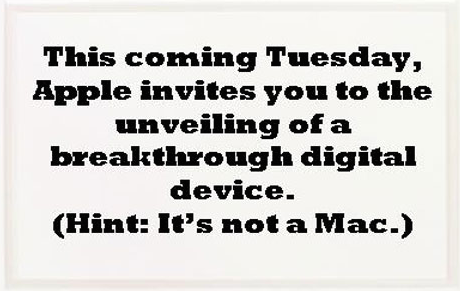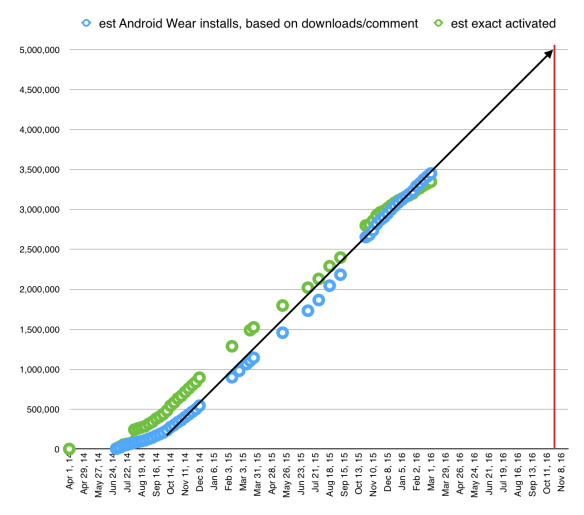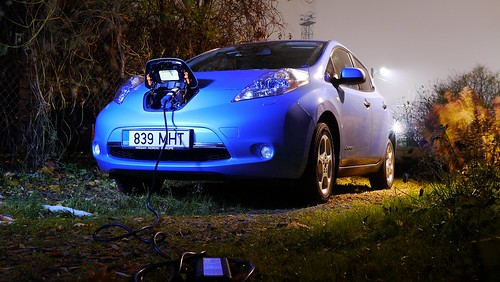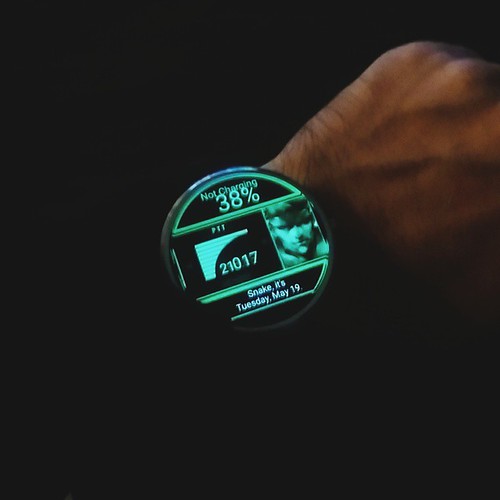
Watches could get smaller yet. Photo by JonChanLon on Flickr.
Late in September 2001, Apple invited some American journalists to a little event on its campus. The invite said “Hint: it’s not a Mac.”

Not a Mac? Maybe a printer?
The product turned out to be the iPod – a music player that, as Slashdot’s editor Cmdr Taco famously remarked of its specifications that it had “No wireless. Less space than a [Creative Labs] Nomad” and hence was “Lame”.
We all know how the story turned out; the iPod trampled all the rivals in the space, capturing interest in music players at the time when phones weren’t quite capable of doing all the things one might want from a music player on the move. At the very least, an iPod was easier and faster to load up and navigate than even the phones that were around then.
But look at what the original iPod looked like. If you come across one now, it seems a giant hulking thing. 5GB of storage on a spinning hard drive! It weighed 184g, and had a volume of 124.9 cubic centimetres. It didn’t sell that well either.
Talking ’bout a second generation
Then in July 2002 the second-generation iPod came out: this had a touch-sensitive wheel, double the storage capacity (for an extra 3g in weight) in a package with a volume of 118.7 cubic centimetres – very slightly less volume, you’ll notice.
Fast forward four years from the original, to September 2005, and you had the iPod nano – 4GB of storage, 42.5g (that’s a quarter of the weight), in a volume of 24.9 cubic centimetres (that’s one-fifth of the original’s volume).

It started big and got smaller (and bigger)
It’s pretty obvious what happens: Apple optimises along certain hardware improvement axes. Screens got larger and added colour while the body got smaller and the controls remained largely the same (even the screenless iPod shuffle has similar controls to its parent, though without the moving scroll wheel).
So the first generation is just the beginning. The hardware will improve in various ways. The question is, which?
Experience: a perfect teacher, if you’re willing to learn
And so we come to the Apple Watch. I’ve been testing one loaned to me by Apple for about four months now. It’s a classic case where a hurried verdict won’t work. Reviewers who tried to decide on its usefulness in a weekend of testing missed the point, I think. There are two things to bear in mind about the Apple Watch (and arguably any smartwatch):
• the products you see now are version one. Everything about them is going to get better
• these are products which have to find a place in your life: every person only understands them in the context that they fit into their own life
The first point is the one that’s easiest to overlook. I’ll lay out the easy criticisms first, because it’s staringly obvious if you look at the iPod data above that lots of these are just hardware issues that will vanish as time goes by.
So here are easy criticisms of the Apple Watch:
• the display doesn’t always detect when you’ve rotated your wrist to view it, so doesn’t always light. This is definitely my biggest bugbear; so sometimes I have to tap the display. Is this a software/gyroscope thing? Definitely. Can it be improved by an update? I’d bet on it.
• the display isn’t lit all the time, so you can’t always see the time. Is this a technology thing? Yup – Android Wear watches have solved this already, so this is not out of reach. (Implementing this would also solve the first problem.)
• the battery doesn’t last for 50 years. In fact, the question people have asked me most often about it is “does the battery last all day?” to which I honestly can answer “Yup”. I often find I can get up to two days or so. If I’m wearing a watch, I don’t like taking it off at night; I like to be able to see the time. So I tend to put the Watch on “power reserve” overnight, which uses about 1% of battery during my typical sleeps, and then charge it first thing in the morning. You can pretty easily get two days of use if you don’t do a lot of exercise. Ben Wood of CCS Insight makes the excellent point about wearables in general: every time you have to take them off to charge them increases the chance you won’t put them back on, perhaps ever.
• third-party apps are slow to load. Uh, yeah. They’re running off the phone, which is talking back and forth with them via Bluetooth. This is going to be solved to a large extent by Watch OS2, due for release imminently. In fact Watch OS2 might fix a number of these things, at least to some extent.
All these things – battery life, display technology, processor speed – are works-in-progress. They haven’t reached an endpoint. You can bet that they will get better, and possibly quite quickly. Think about that in the context of those annoyances listed above.
Now here are the things where it seems to me the Watch is a huge advance on just having an iPhone:
• maps and directions. On the very first day I started using the Watch, I had to walk to another venue. I put the destination in on my phone, started the directions, put the phone in my pocket, and the watch took over – with the Taptic Engine tapping my wrist to indicate it was time to turn left or right (two for left, three for right). Walking along and looking occasionally at your watch is a lot more comfortable than gazing into your phone, or taking out your phone anxiously to see what you should do. (This is the first use that I cite to anyone who asks what it’s useful for; and when I tell them, they get an “ooh, useful” look.)
The same applies when driving – getting direct tactile feedback when a turn is coming up is a hell of a lot more useful than having to glance back and forth from the road to a screen. (The husband of a friend apparently likes the direction system so much he attaches his to his steering wheel. I don’t recommend this.)
• The Taptic Engine is a hell of a useful thing: together with the sounds, it lets you distinguish between an incoming message, a phone call, a calendar event coming due, a notification from another app (I find Dark Sky’s rain warnings helpful), and so on. Again, it’s something you just don’t get elsewhere.
• not having to be tethered to my phone. Of course, your phone still has to be in range (though once Watch OS 2 comes out, only on a Wi-Fi network that both your Watch and phone recognise). I’ve had the experience of being one floor up doing some DIY and having a phone call coming in to my phone a floor below. I took the call on the watch.
• quick responses to (or ignoring) messages. When a message comes in, you can see what it is and ignore it, use a pre-filled response, or dictate a reply. Siri is darned good on the dictation.
• the exercise measurement. I know that this is like Skinner boxes (pretty much the first thing I did was to turn off the “stand at 10 minutes before the hour” notification), but having something passively measuring how much activity you’re doing makes you consider it. Jim Dalrymple’s post on the huge effect that small but cumulative actions can have is inspiring; to that extent, I don’t care if the heart monitor is 100% accurate, as long as it’s consistent. And it seems to have a pretty clear idea of how much physical activity I’ve done in a day. Again, you don’t get that psychological benefit by testing for a weekend.
• it’s personal. Everyone sets their Watch up differently. I like having the “multiple” face, on which I have sunset/sunrise (this matters to me, for domestic reasons); exercise rings; time; day and night temperature highs and lows (this also matters, for domestic reasons; and the charge. There are tons of other things I like – being able to advance songs on the phone, or to like/hate songs on Apple Music, and so on.
The hardest part of using an Apple Watch is definitely getting the notifications under control. It would be easy to have everything on it; but you don’t need email, or tweets, or Instagram, or a ton of other things. The value is in having only the things that are very important to you; in that sense the Watch becomes a sort of proxy assistant (though one you have to set up yourself) which filters most of the crap out. You decide what of the crap you want to have.
Do you believe in the future?
I thought the reaction of the fashion industry to the Watch might be indicative. Apple courted it intensely ahead of and after its launch. There’s not much sign of how much penetration it has achieved there.
But those who would like to call the Watch a flop are, as usual, premature. If you’d seen the first six quarters’ sales of the iPod, you’d have concluded that that was a flop too. Here’s how they looked:

The pattern for iPod sales at the start isn’t encouraging.
Pretty terrible, right? The sixth quarter is below the very first quarter, for a product that was only on sale for part its first quarter. And yet the iPod went on to define an industry.
What happened after those six quarters? Here’s the view over 13 quarters, with the sudden growth coming after the introduction of the iPod mini – which, let’s note, had a capacity of 4GB (less than the original, or the “classic” iPods then available, which started at 15GB) but a weight of only 104g (compared to 158g for the larger “classic” version) and a volume of 58.7 cubic centimetres, compared to 99.6 cubic centimetres for the “classic” version then on sale.

That looks healthier.
Clearly, people like lighter and smaller – a trend that Apple has been happy to fulfil with its phones. I can’t see it not doing exactly the same with its Watches as time progresses. Will they be as useful?
Put it this way: do you really think that the smartphone is the endpoint of communications development? Do you think that communication cannot get any more personal? Smartwatches are already showing us that actually, you can do more, and do it even more personally. (Samsung’s out in the lead by adding 3G capability to its models; again, do you think smartwatches will never want that?)
U say UX, I say choices
What about the fact that the Apple Watch is sort of squarish, while Motorola and most recently Samsung have gone for a round face? (Samsung has a particularly nifty UI involving turning the top of the face to scroll through options.)
Obviously this is a choice. A round face is ideally optimised for showing the sweep of hands, and also for turning things. It’s not so good, though, for displaying text. You either have to squash it in, or justify like mad, or reduce the text font size. None is optimal for text display.

Your round watch face isn’t so good at showing text.
I find the Watch’s text size is just big enough to read without the glasses I need to read my phone. There’s probably a font legibility element in there too – San Francisco, the font on the Watch, is slightly different from that on the iPhone.
Flop, fly, forecast
It’s easy to declare that peoples’ inability to grok what a smartwatch really is about means that the category is a flop, and won’t be useful. I think we’re instead going to see a parallel development: the technology will improve, and people will see situations where the phone just doesn’t quite do enough – but a smartwatch would. Apple’s adverts on this latter point are a slow burn; but it’s coming.
The fairest evaluation of the first-generation Apple Watch? It does much more than you might ever expect (and damn, it’s a million times more useful than my Pebble ever was), even at the cost of a couple of annoyances that mark it out as a first-generation product. Technology improves. Our need to communicate remains consistent. The intersection of usefulness and demand will come, and we’ll probably take it for granted when it does.

























